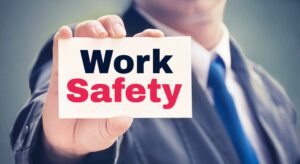Workplace safety is a pressing issue for most organizations, especially those with manufacturing or production units. The International Labour Organization (ILO) estimates that 2.3 million individuals die from work-related diseases or accidents annually, which equates to a whopping 6,000+ deaths each day. At the same time, it estimates 160 million victims of work-related ailments per year, along with 340 million occupational accidents annually as well.
Workplace health and safety is thus imperative for companies, especially with regard to ensuring suitable environments for employees, along with minimizing the chances of mishaps. It contributes immensely toward a healthy, happy, and more productive workforce. If you are concerned about the issue, then there are a few steps that you should keep in mind. Here’s learning more about the same below.
ALSO READ: 5 Questions You Need to Remember Before Buying Health Insurance

Workplace safety steps- Include these in your checklist
- Stay alert about the surroundings– Examine your workplace environment closely and be alert about any potential mishaps or hazardous scenarios. Avoid risky areas as much as you can to bypass accidents.
- Take periodic breaks– If you’re working strenuously for long hours without periodic breaks, then you’re automatically increasing the risks of injuries at work. Make sure that you avoid daily burnout by taking breaks between shifts, especially if you’re working at construction sites, manufacturing units, and other industries.
- Use equipment carefully– While several workplace tools may be difficult to operate and risky, you should minimize the chances of mishaps by learning how to use them correctly. Do not go for shortcuts or experiments, since this may otherwise lead to major injuries. Ensure that you’re using suitable tools for particular tasks.
- Look out for risky workplace conditions– One of the biggest ways to ensure higher workplace health and safety is to continually keep a lookout for unsafe situations. Inform your manager/leadership instantly about such unsafe scenarios which may lead to accidents in the future. Ensure that you have coverage under group health insurance if your job has a specific risk element.
- Safeguard your back– A majority of back injuries result from improper posture. The issue only worsens for those with desk jobs. Avoid slouching and bend your knees while picking up items from the floor. Ensure that you stretch your back properly.
- Deploy mechanical tools for heavy lifting– Doing it yourself may lead to mishaps and injuries. Use mechanical tools like conveyor belts and forklifts to safeguard yourself from accidents in this case.
- Always use safety equipment– Workplace safety levels automatically increase when workers use proper safety equipment including hard hats, face masks, gloves, goggles, hearing protection items, harnesses, and more, depending on the nature of the job. Do not avoid wearing the same at any time.
- Do not consume alcohol in the workplace– Consumption of alcohol is not only irresponsible at work, but also risky. It may hinder your alertness and movements, leading to higher chances of injuries. Do not consume it either at work or before you start your day.
- Get health insurance– Health insurance is a must for everyone, irrespective of their nature of work. There are various health insurance plans that you can check out, with varying features, inclusions, and exclusions. Choose the plan that suits your needs, while using a health insurance calculator to work out the payable premium every year. Do not skimp on coverage, since health insurance will ensure the financial protection of your family in the event of sudden accidents, hospitalization, treatments, and other medical costs. It should be the first step in your checklist.
- Note emergency exits carefully– The workplace should have defined emergency exits for risky scenarios. Note them carefully for enhanced protection.
MUST READ: Life Insurance Purchases: Dos And Don’ts
Companies should also provide workplace health and safety training to employees along with training in basic first aid measures. They should also note the above-mentioned aspects and tailor their environments and working conditions accordingly. Of course, it goes without saying that adequate group health insurance is a must for financially safeguarding workers and their families in the event of an accident/injury.








